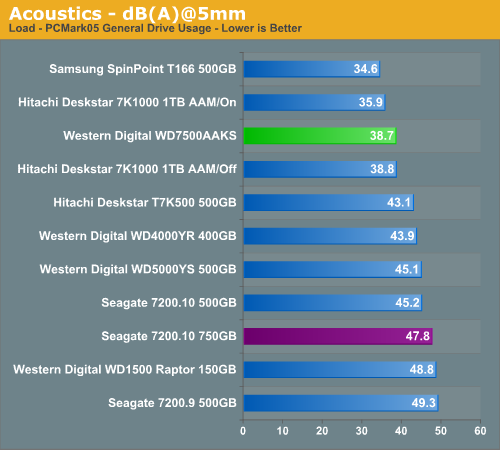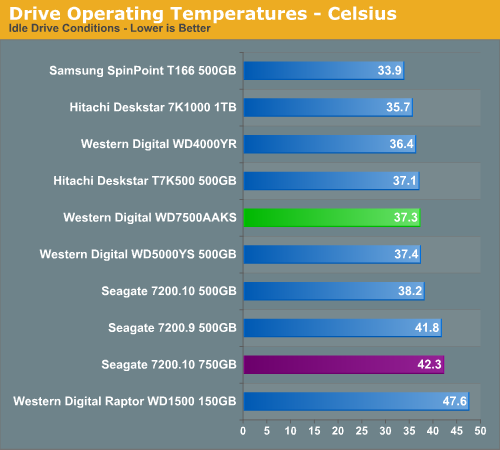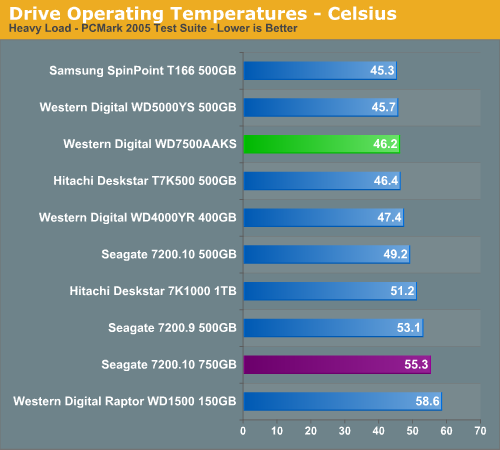Western Digital SE16 750GB: "Quiet" a Performer
by Dave Robinet on August 9, 2007 2:00 AM EST- Posted in
- Storage
Acoustics
Our acoustic test utilizes our standard test bed components but we implement Intel's power saving technology and turn off the case fans to eliminate as much case noise as possible during testing. Our Corsair power supply is nearly silent in these tests and our MSI 8800GTX video card is water cooled by an external pump/radiator unit to provide a further decrease in our case's ambient noise levels. Our drives are attached to the drive cage with rubber bushings to assist in isolating the noise of the drive and avoid the resulting harmonic changes due to the case design.
Our acoustic tests are designed to measure the decibel levels while the system is at idle and also under load while running the General Hard Disk Drive Usage benchmark within PCMark 2005. We found through trial and error that this particular benchmark produces controlled readings across a wide range of applications within the benchmark. This particular benchmark utilizes 60% reads and 40% writes within the trace playback file.
The measurements are taken at a distance of 5mm from the rear and front of the drive being tested in order to minimize surrounding environmental noise. We have noticed that unless we run a completely silent system in a quiet room that measurements taken from 1m are generally not meaningful because they are lost in the surrounding ambient noise. There are exceptions - like the Raptor series of drives - but overall most modern desktop drives are quieter now than the other components in the system.
The reported measurements are based on an A-weighted decibel score that measures frequencies similar to the way the human ear responds to sound. We take a total of three measurements for each test. We then subtract the high and low scores and arrive at our findings by reporting the remaining score. Our base dB(A) level in the room at time of testing was 25 dB(A).


Western Digital's claim of a quiet drive is indeed backed up by our acoustic measurements, though it cannot claim to be the quietest. Its idle noise measurement of just over 30dB(A) makes it a few decibels louder than both the Hitachi 7K1000 and the Samsung T166 drives which we've recently tested in the AnandTech labs. The score does represent nearly a 3 decibel reduction from any Western Digital drive we've previously tested, however, and easily bests the Seagate 750GB 7200.10.
The drive's activity measurements of 38.7dB(A) show the same pattern. The drive is still roughly 4 decibels louder than the whisper-quiet SpinPoint T166, but shows up substantially better than most other desktop drives in this class. The noise emitted by the drive during periods of activity can best be described as a low "thumping" or "pulsing" noise that was not obtrusive but noticeable at times.
Thermals
Our thermal tests utilize sensor readings via the S.M.A.R.T. (Self-Monitoring, Analysis and Reporting Technology) capability of the drives and are reported by utilizing the Active SMART 2.42 utility. We also utilize thermal sensors and infrared measurement devices to verify our results. We test our drives in an enclosed case environment without the fans operational to simulate temperatures that could conceivably be reached in a near silent SFF or HTPC case design. We typically find the reported numbers drop anywhere from 18% to 25% with the case fans operational. Our base temperature level in the room at the time of testing was 25C.


At 37.2C idle, the WD7500AAKS ends up in the middle of the pack. The situation improves dramatically, however, when the drive is under heavy load, coming in at an impressive 46.2C. This score is currently bested only by the Samsung T166 and the WD7500AAKS's smaller sibling, the 500GB WD5000YS. Keep in mind that larger drives with more platters usually generate more heat, so the temperature result is all the more impressive.
Our acoustic test utilizes our standard test bed components but we implement Intel's power saving technology and turn off the case fans to eliminate as much case noise as possible during testing. Our Corsair power supply is nearly silent in these tests and our MSI 8800GTX video card is water cooled by an external pump/radiator unit to provide a further decrease in our case's ambient noise levels. Our drives are attached to the drive cage with rubber bushings to assist in isolating the noise of the drive and avoid the resulting harmonic changes due to the case design.
Our acoustic tests are designed to measure the decibel levels while the system is at idle and also under load while running the General Hard Disk Drive Usage benchmark within PCMark 2005. We found through trial and error that this particular benchmark produces controlled readings across a wide range of applications within the benchmark. This particular benchmark utilizes 60% reads and 40% writes within the trace playback file.
The measurements are taken at a distance of 5mm from the rear and front of the drive being tested in order to minimize surrounding environmental noise. We have noticed that unless we run a completely silent system in a quiet room that measurements taken from 1m are generally not meaningful because they are lost in the surrounding ambient noise. There are exceptions - like the Raptor series of drives - but overall most modern desktop drives are quieter now than the other components in the system.
The reported measurements are based on an A-weighted decibel score that measures frequencies similar to the way the human ear responds to sound. We take a total of three measurements for each test. We then subtract the high and low scores and arrive at our findings by reporting the remaining score. Our base dB(A) level in the room at time of testing was 25 dB(A).


Western Digital's claim of a quiet drive is indeed backed up by our acoustic measurements, though it cannot claim to be the quietest. Its idle noise measurement of just over 30dB(A) makes it a few decibels louder than both the Hitachi 7K1000 and the Samsung T166 drives which we've recently tested in the AnandTech labs. The score does represent nearly a 3 decibel reduction from any Western Digital drive we've previously tested, however, and easily bests the Seagate 750GB 7200.10.
The drive's activity measurements of 38.7dB(A) show the same pattern. The drive is still roughly 4 decibels louder than the whisper-quiet SpinPoint T166, but shows up substantially better than most other desktop drives in this class. The noise emitted by the drive during periods of activity can best be described as a low "thumping" or "pulsing" noise that was not obtrusive but noticeable at times.
Thermals
Our thermal tests utilize sensor readings via the S.M.A.R.T. (Self-Monitoring, Analysis and Reporting Technology) capability of the drives and are reported by utilizing the Active SMART 2.42 utility. We also utilize thermal sensors and infrared measurement devices to verify our results. We test our drives in an enclosed case environment without the fans operational to simulate temperatures that could conceivably be reached in a near silent SFF or HTPC case design. We typically find the reported numbers drop anywhere from 18% to 25% with the case fans operational. Our base temperature level in the room at the time of testing was 25C.


At 37.2C idle, the WD7500AAKS ends up in the middle of the pack. The situation improves dramatically, however, when the drive is under heavy load, coming in at an impressive 46.2C. This score is currently bested only by the Samsung T166 and the WD7500AAKS's smaller sibling, the 500GB WD5000YS. Keep in mind that larger drives with more platters usually generate more heat, so the temperature result is all the more impressive.










37 Comments
View All Comments
bigpow - Thursday, August 9, 2007 - link
signs of times..when we no longer perceived Made in China as a bad thing, I've been hearing that it's actually preferred over the recent streams of Made in Thailand electronics.
It happened to Japan & Taiwan before, now most people are happy to see those labels when they buy something.
And of course, the cool-er things in life are still Made in USA ;)
-Not that where something is produced has anything to do with the quality.
Googer - Thursday, August 9, 2007 - link
I noticed the Western Digital Raptor 150 was missing from this chart:http://images.anandtech.com/graphs/wd750_080807108...">http://images.anandtech.com/graphs/wd750_080807108...
Gary Key - Thursday, August 9, 2007 - link
I have no idea why, but after hitting our engine update button again, it is there now. :)Googer - Thursday, August 9, 2007 - link
In your benchmarking, you did not mention the size of the swapfile you have your OS set to use. I am sure it has an effect on application throughput. A static sized file is needed for benchmarking consistency.Gary Key - Thursday, August 9, 2007 - link
Our standard swapfile is fixed at 2048MB and we clean the prefetch folder after each benchmark run.imaheadcase - Thursday, August 9, 2007 - link
You can fill a WHS with 6 1TB drives for so cheap it will be great! Acoustics and heat will be a selling point for lots of people what that comes around.yyrkoon - Monday, August 13, 2007 - link
Heh, have you ever owned a 'Deathstar' ? Many, including myself will never venture down that road again.Martimus - Wednesday, August 15, 2007 - link
I have avoided IBM drives after mine died on me after only about one year. Of course Hitachi bought them out, but I don't know if they have any better longevity than they used to.strikeback03 - Tuesday, August 14, 2007 - link
An Emachines computer I bought a few years ago had a Deskstar drive. Other than the anti-static meowing noise, no problems with it for the 3 years I owned it.mostlyprudent - Thursday, August 9, 2007 - link
I am most impressed at how well the Hitachi 1TB drive continues to sit at the top of so many of the benchmarks.Your conclusion stating how well the WD drive does against the Seagate omitted the point raised in the Samsung article recently posted here. That is, Seagate's drive is almost a year older and their new 7200.11 drives are just around the corner.
Overall, it is impressive to see how tightly grouped these drive are. There seems very little reason to even consider a Raptor anymore.